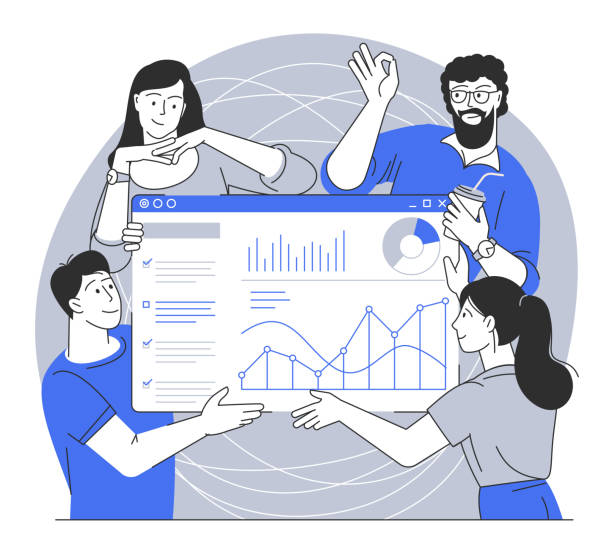Why Website Speed is the Cornerstone of Online Success?
In today’s fast-paced world, website loading speed is not just a competitive advantage, but has become an absolute necessity.
Today’s users have little patience and expect websites to load instantly.
Fast website design means optimizing all technical and content aspects so that visitors can access the information they need in a fraction of a second.
A slow website can lead to the loss of potential customers, reduced conversion rates, and serious damage to your brand’s reputation.
According to reputable research, even a one-second delay in page load time can cause up to a 7% decrease in conversion rates.
These statistics indicate the vital importance of fast website design.
This explanatory introduction helps you understand why you should pay more attention to this topic than ever before.
Imagine entering a store where you have to wait 10 minutes for each product’s information to be displayed; would you return there? Certainly not.
The same example applies to websites.
A website that loads quickly not only provides a better user experience (UX) but also ranks higher in the eyes of search engines like Google.
Google has officially announced that site speed is a ranking factor and penalizes slow websites.
Therefore, for SEO success and attracting more organic traffic, website speed optimization is an essential step.
This topic is of great importance for any online business, from small online stores to large news platforms, and should not be ignored.
Losing business opportunities because of an outdated website? With Rasawab, permanently solve the problem of not attracting potential customers through your website!
✅ Attract more high-quality leads
✅ Increase brand credibility in the eyes of customers
⚡ Get free corporate website design consultation
Fundamental Concepts in Building a High-Speed Website
To achieve fast website design, we must first become familiar with the fundamental concepts and main factors affecting site speed.
This educational section helps you gain a deeper understanding of the components of website speed.
Factors affecting site speed include page size, number of HTTP requests, image optimization, caching, server responsiveness, and the use of a Content Delivery Network (CDN).
Each of these plays a key role in the final site load time.
For example, the smaller the size of a web page (including HTML, CSS, JavaScript, images, and videos), the faster it loads.
The number of HTTP requests is also another important factor.
Each separate file (such as an image, a CSS file, or a JavaScript file) requires a distinct HTTP request from the server.
Reducing the number of these requests by combining files or using CSS sprites can significantly improve speed.
Also, server responsiveness, known as TTFB (Time To First Byte), indicates the time it takes for the browser to receive the first byte of information from the server.
This time is influenced by hosting quality, server configuration, and backend coding.
A high loading speed means optimal management of these factors.
Understanding these basic concepts is the first step for any effective action towards increasing website speed and allows you to identify potential weaknesses in your site.
Front-End Technical Optimizations for Higher Speed
Optimizing the front-end or user interface is one of the most important steps towards fast website design.
This section includes all elements that the user directly interacts with and that are loaded in their browser.
Image optimization plays a very vital role in this area; high-volume images can severely reduce loading speed.
Using next-generation image formats like WebP, compressing images without significant quality loss, and lazy loading images that only load when they enter the user’s viewport, are effective methods.
Browser caching is also a powerful tool for increasing speed.
By setting appropriate cache headers, the user’s browser can be instructed to store certain files (such as CSS, JavaScript, and images) in its local memory for a specific period.
This ensures that on subsequent visits, there is no need to re-download these files from the server, significantly increasing loading speed.
Furthermore, compressing and minifying (Minification) CSS and JavaScript files helps remove extra characters like white spaces, comments, and new lines, which leads to reduced file size and faster loading.
Using optimized code and removing unnecessary code is also very important in this regard.
These technical measures are essential for any website seeking to improve user experience and SEO ranking.
The table below highlights some of the most common front-end optimization techniques:
| Optimization Technique | Description | Impact on Speed |
|---|---|---|
| Image Optimization | Reduce image size with appropriate formats (WebP), compression, and Lazy Loading. | Very High (Reduces overall page size) |
| Browser Caching | Stores files in the user’s browser for subsequent visits. | High (Improves experience for repeated visits) |
| Minification | Removes extra characters from CSS/JS files. | Medium (Reduces download size) |
| Gzip/Brotli Compression | Compresses files before sending to the browser. | High (Reduces data transfer time) |
Click here to preview your posts with PRO themes ››
The Importance of Server and Backend Infrastructure in Loading Speed
In addition to front-end optimization, server infrastructure and backend coding also play a pivotal role in fast website design.
A slow server, even with the most optimized front-end, will still lead to an unpleasant user experience.
Choosing suitable hosting is the first and perhaps most important step in this area.
Cheap shared hosts might initially seem cost-effective, but they often have limited resources and severely reduce site performance during peak traffic.
Cloud hosting, Virtual Private Servers (VPS), or dedicated servers are better options for websites with high traffic or a need for consistent performance.
Database optimization is also a crucial factor.
Inefficient database queries, large and unindexed tables, and redundant data can significantly increase server response time.
Using database caching, optimizing queries, and removing old and unnecessary data all contribute to improving backend performance.
A Content Delivery Network (CDN) is also a powerful solution for increasing global site speed.
A CDN stores your website’s static content (such as images, CSS, and JavaScript) on multiple servers worldwide, and when a user visits your site, the content is delivered to them from the closest server.
This minimizes latency (network delay) and significantly improves the user experience, especially for audiences accessing your site from distant geographical locations.
These technical approaches ensure that your site has a strong and high-speed foundation.
Do you have an e-commerce site, but your sales aren’t as you expect? Rasawab permanently solves your problem by designing professional e-commerce websites!
✅ Significant increase in conversion rates and sales
✅ Unparalleled user experience for your customers
⚡ Click to get free consultation from Rasawab!
Tools and Methods for Measuring Website Speed
To ensure that your efforts towards fast website design have yielded results, you need precise tools for measuring and monitoring site speed.
This section guides you to become familiar with the most commonly used tools and evaluate your site’s performance.
Website speed measurement tools allow you to identify your site’s strengths and weaknesses and take corrective actions based on real data.
One of the most popular tools is Google PageSpeed Insights, which not only evaluates your site’s speed on desktop and mobile but also provides suggestions for performance improvement.
This tool uses metrics such as LCP (Largest Contentful Paint), FID (First Input Delay), and CLS (Cumulative Layout Shift), all of which are part of Google’s Core Web Vitals and directly impact SEO.
Another widely used tool is GTmetrix, which provides more precise details about load time, page size, and the number of requests, and includes Waterfall charts for deeper analysis.
WebPageTest is also a more advanced tool that allows you to run tests from different geographical locations and with various browsers.
Regular use of these tools and continuous speed monitoring helps you always ensure your site’s optimal performance and quickly identify and resolve any speed drops.
This is an analytical and essential approach for maintaining a high-performing website.
The Impact of Site Speed on SEO and User Experience
Site speed is no longer just a technical feature; rather, it directly impacts two critical aspects of online success: Search Engine Optimization (SEO) and User Experience (UX).
This close connection is the main reason why fast website design is so important.
From an SEO perspective, Google and other search engines have explicitly stated that page load speed is a ranking factor.
Faster websites achieve higher rankings in search results, which means more organic traffic and, ultimately, more customers and revenue.
Search engine crawlers also prefer to crawl fast sites more frequently and efficiently, which helps in better indexing of your content.
On the other hand, the impact of speed on user experience is undeniable.
A slow site frustrates users and causes them to abandon the page (increasing bounce rate or Bounce Rate).
Users expect pages to load in less than 2 to 3 seconds, and in case of delay, they quickly move to a competitor’s website.
A fast website encourages users to stay longer on the site, view more pages, and have more positive interactions.
This leads to increased conversion rates, customer loyalty, and improved brand reputation.
Furthermore, high speed, especially on mobile devices, has added importance, as many users access websites via mobile internet with varying speeds.
This analytical section demonstrates that investing in website speed is, in fact, an investment in the future of your online business.
Common Mistakes in Website Design and Ways to Avoid Them
On the path to achieving fast website design, many developers and website owners make mistakes that can nullify their efforts.
Recognizing these common mistakes and knowing how to avoid them can help you build a truly high-speed website.
This section raises thought-provoking content and provides practical guidance for preventing issues.
Common website speed mistakes include using unoptimized images, render-blocking JavaScript and CSS, choosing unsuitable hosting, not using caching, and high volume of web fonts.
One of the biggest mistakes is neglecting the size of image files.
High-resolution and high-quality images uploaded to the site without compression can quickly increase page size to several megabytes.
Lack of minification and compression of CSS and JavaScript files also causes the browser to spend more time downloading and processing these files.
Furthermore, overloading plugins or extensions in Content Management Systems like WordPress can heavily consume server resources and reduce speed.
Failure to utilize a CDN for global content distribution, especially for websites with international audiences, leads to increased Latency and slow loading.
Finally, lack of regular website speed monitoring and neglecting reports from tools like PageSpeed Insights are other major mistakes.
To solve these issues, a systematic approach to optimization must be adopted, and site performance continuously reviewed.
The table below lists some common mistakes and solutions to counter them:
Click here to preview your posts with PRO themes ››
| Common Mistake | Negative Impact | Solution |
|---|---|---|
| Large and Unoptimized Images | Increased page size and loading time | Use WebP, compression, Lazy Loading |
| Uncompressed CSS/JS files | Increased download and parsing time | Minification and Gzip/Brotli |
| Unsuitable Hosting | Slow server response (High TTFB) | Choose quality hosting (VPS, Cloud) |
| Lack of CDN usage | Increased Latency for distant users | Implement CDN for static content |
Future Trends in Web Performance Optimization
The web world is constantly evolving, and with it, the methods and technologies for fast website design are also advancing.
Awareness of future trends in web performance optimization can help you prepare your site for the future and stay ahead of competitors.
This news section explores some of these exciting trends.
New high-speed web technologies include the emergence of next-generation image and video formats, advancements in network protocols, and the expansion of Progressive Web Apps (PWAs).
Image formats like AVIF and JPEG XL, which are a new generation of WebP, promise more compression with better quality and are currently supported by major browsers or are under development.
These formats can significantly reduce image sizes and contribute to faster site loading.
In network protocols, HTTP/3, built upon the QUIC protocol, is designed to reduce latency and improve performance on unstable networks.
Its widespread adoption will help increase overall web speed.
Progressive Web Apps (PWAs) are also a new approach that provides a native application user experience through the web.
PWAs can work offline, have stronger caching, and support push notifications.
These technologies not only help increase website speed but also elevate the user experience to a new level, and it seems the future of the web lies in implementing such solutions.
Paying attention to these growing trends is essential for anyone looking to maintain competitiveness and deliver the best online performance.
Does your company’s website perform as it should for your brand? In today’s competitive world, your website is your most important online tool. Rasawab, specializing in professional corporate website design, helps you to:
✅ Attract customer credibility and trust
✅ Convert website visitors into customers
⚡ Get free consultation!
The Role of User Interface (UI) and User Experience (UX) in Perceived Speed
When it comes to fast website design, we often focus on its technical aspects.
However, User Interface (UI) and User Experience (UX) also play a significant role in “Perceived Performance”.
This explanatory and engaging section shows you how design tricks can create a sense of speed for users, even before all content is fully loaded.
Perceived speed means how fast the user feels the site is, not necessarily its actual technical speed.
Using smart loading animations, skeleton screens that display a general outline of the page before content fully loads, and progressive loading of elements all help reduce the user’s sense of waiting.
For example, instead of showing a blank white page, displaying a grey outline of upcoming content reassures the user that the site is loading and keeps them engaged.
Also, optimizing the Critical Rendering Path means prioritizing the loading of content that appears at the top of the page and is first visible to the user.
This ensures that the user can interact with the site’s main content as quickly as possible.
Responsive design and smooth animations also contribute to creating a sense of speed and fluidity in the user experience.
Even if all technical aspects are optimized for high speed, poor design can convey a feeling of slowness to the user.
Therefore, combining technical optimization with smart UI/UX design is key to achieving a truly fast and enjoyable user experience.
Click here to preview your posts with PRO themes ››
The Importance of Continuous Updates and Maintenance for Speed Retention
Fast website design is not a one-time process, but an ongoing effort.
After launching an optimized website, the importance of continuous updates and maintenance for preserving its speed and performance is undeniable.
This section guides you on how to ensure your site remains fast over time.
Continuous site maintenance includes updating the Content Management System (CMS), plugins and themes, regular database optimization, and checking for broken links and server errors.
Content Management Systems like WordPress, Joomla, and Drupal regularly release updates that include performance improvements, bug fixes, and security patches.
Failure to update can not only jeopardize your site’s security but also lead to its slowdown.
Outdated and incompatible plugins and themes can also waste server resources and cause conflicts.
Therefore, always ensure you are using the latest stable versions and remove unnecessary plugins.
Regular database cleanup and optimization are also crucial.
Redundant information, spam comments, old post revisions, and expired cached data can increase database size and reduce query speed.
Regular backups of the site and database are also essential, so that in case of any issue, you can quickly restore the site to its previous state.
Continuous monitoring with speed test tools and reviewing reports from Google Search Console also helps you immediately detect any performance drops and take necessary actions.
This commitment to continuous optimization is the key to your site’s stability and long-term success in the digital world.
Frequently Asked Questions
| No. | Question | Answer |
|---|---|---|
| 1 | What is the concept of “fast website design”? | Designing a website that loads in the shortest possible time and provides a smooth user experience, with an emphasis on performance optimization. |
| 2 | Why is website loading speed important for users? | Today’s users have little patience; slow websites lead to early page abandonment, poor user experience, and loss of visitors. |
| 3 | What impact does fast website design have on SEO? | Search engines like Google consider site speed as a ranking factor. Faster websites achieve better rankings in search results. |
| 4 | What are the main factors affecting site speed? | Image optimization, caching, CSS and JS file compression, using strong hosting, reducing HTTP requests, and optimized coding. |
| 5 | How can website loading speed be measured? | By using tools such as Google PageSpeed Insights, GTmetrix, Lighthouse, and Pingdom Tools, which provide detailed performance reports. |
| 6 | What is the role of images in website speed and how should they be optimized? | High-volume images can severely reduce site speed. They should be compressed, modern formats (like WebP) should be used, and the Lazy Load technique should be employed. |
| 7 | What is the importance of choosing suitable hosting in fast website design? | A powerful and high-speed hosting (preferably SSD) with optimized servers close to target users is the foundation of a website’s speed. |
| 8 | How does Caching help increase website speed? | Caching allows the user’s browser to store copies of site files, so on subsequent visits, there’s no need to reload all content, and the site is displayed faster. |
| 9 | Is using a CDN (Content Delivery Network) recommended in fast website design? | Yes, a CDN significantly increases loading speed by storing copies of site content on various geographical servers and delivering it from the closest server to the user. |
| 10 | What are the key tips for developers to design a high-speed website? | Writing clean and optimized code, minimal use of plugins, optimizing database queries, using lightweight frameworks, and implementing Lazy Load for content. |
And other services of RasaWeb Advertising Agency in the field of advertising
Smart Direct Marketing: A combination of creativity and technology for online growth through attractive UI design.
Smart Advertising Campaign: Revolutionize SEO ranking improvement with the help of user experience customization.
Smart Link Building: A new service for increasing campaign management through marketing automation.
Smart Advertising Campaign: A new service for increasing website traffic through Google Ads management.
Smart Social Media: A creative platform for improving customer behavior analysis with precise audience targeting.
And over a hundred other services in the field of internet advertising, advertising consulting, and organizational solutions
Internet Advertising | Advertising Strategy | Advertorial
Sources
The Importance of Web Speed in SEO
Fast Website Design: Why is it Important?
Website Performance and User Experience
Comprehensive Guide to SEO and Site Speed
? Are you ready to transform your business in the digital world? Rasawab Afarin, with expertise in comprehensive digital marketing services including corporate website design, paves your path to growth.
📍 Tehran, Mirdamad Street, next to Bank Markazi, Southern Kazeroon Alley, Ramin Alley, No. 6















